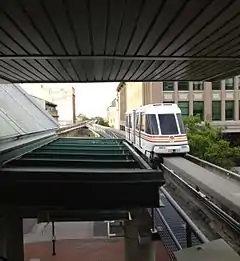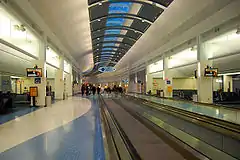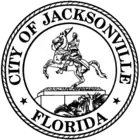Transportation in Jacksonville, Florida
The Jacksonville transportation network includes ground, air, and sea options for passenger and freight transit. The Jacksonville Port Authority (Jaxport) operates the Port of Jacksonville, which includes container shipping facilities at Blount Island Marine Terminal, the Talleyrand Marine Terminal and the Dames Point Marine Terminal. Jacksonville Aviation Authority managers Jacksonville International Airport in Northside, as well as several smaller airports. The Jacksonville Transportation Authority (JTA) operates bus, people mover, and park-n-ride services throughout the city and region. A major bus terminal at the intermodal Rosa Parks Transit Station serves as JTA's main transit hub. Various intercity bus companies terminate near Central Station. Amtrak operates passenger rail service to and from major cities throughout North America. The city is bisected by major highways, I-95 and I-10, I-295 creates a full beltway around the city.
Along with bus services, Jacksonville offers fixed routes operated by the Jacksonville Transportation Authority (JTA). The Skyway is a people mover system located in Downtown Jacksonville. Its two lines and eight stations connect the Northbank, Southbank, and Lavilla districts. JTA is in the process of securing funding for an extension into Brooklyn, a neighborhood just south of Lavilla.[1]

Background
Jacksonville is a sprawling city making cohesive walking and bicycling options difficult. Cycling still remains popular in some central urban areas for both recreation and commuting. The city manages to sustain a relatively low amount of traffic congestion for a city of its population, this is mostly related to the vast 767 square miles (1,990 km2)[2] area the city covers, an area much larger than most cities with a population over 800,000. Jacksonville's low population density might also be the reason the city has yet to further develop its mass transit bus system or a heavy or light rail network. Among urbanized areas with a population of 1 million or greater in the United States, Jacksonville ranked tenth in freeway lane miles per 1,000 population and eighth in freeway-equivalent miles per 1,000 population.[3] As the 12th-largest city in the U.S., Jacksonville has repeatedly been ranked below 40th in mass transit availability. As a result, the city is not well known for its walkability.
Jacksonville once had a large streetcar system. On February 24, 1893, Jacksonville began service with its first streetcar line. By the late 1920s, Jacksonville had what was Florida's largest streetcar system, run by multiple different companies. However, by the early 1930s, buses replaced streetcars, and the streetcars slowly perished. The last year of service was 1936.[4]

Mobility issues include:[5]
- Bus-only city mass transit system; the absence of rapid transit and light rail.
- Undue emphasis on automobile travel in city planning; the lack of sidewalks and bike paths.
- Excessive automobile usage resulting in environmental degradation (specifically air pollution), as evidenced by the city's history of poor air quality
- Lack of cross-town bus routes, forcing bus riders to travel downtown to cross from one side of the city to another, often doubling or tripling what the trip distance would have been with a direct route.
- "Lack of vision" in building a transportation network based entirely on non-renewable resources and old technology
- Paucity of scheduled bus routes, often forcing riders to choose between arriving at a destination extremely early, or late.
- Lack of night bus services, which forces those who work late shifts to find other ways to get around. These can be much more expensive.
- Fiscal costs of building (for instance liens), repairing, and replacing roads
There are other concerns over a lack of safe walking paths in many areas of the city. Many suburbs which were incorporated in the consolidation of 1968 don’t have sidewalks. This often forces pedestrians to navigate a narrow road shoulder near high-speed automobile traffic.
Road transportation
Road infrastructure
Interstate highways:
 Interstate 10 routes west to Houston
Interstate 10 routes west to Houston Interstate 95 routes north to Washington, D.C. and runs south to Miami.
Interstate 95 routes north to Washington, D.C. and runs south to Miami. Interstate 295 serves as a beltway routing around the city and connects to all of the interstate highways.
Interstate 295 serves as a beltway routing around the city and connects to all of the interstate highways.
Interstate Highways 10 and 95 intersect in Jacksonville, creating the busiest intersection in the region with 200,000 vehicles each day.[6] Interstate 10 ends at this intersection (the other end being in Santa Monica, California).
A $152 million project to create a high-speed interchange at the intersection of Interstates 10 and 95 began in February 2005, after the conclusion of Super Bowl XXXIX. Construction was expected to take nearly six years with multiple lane flyovers and the requirement that the interchange remain open throughout the project. The previous configuration utilized single lane, low speed, curved ramps which created backups during rush hours and contributed to accidents.[7]
Major arterial highways:
 US 1 The primary north-south local access roadway through downtown Jacksonville.
US 1 The primary north-south local access roadway through downtown Jacksonville. US 17 Roosevelt Boulevard is a major north-south connector from downtown Jacksonville to Clay County.
US 17 Roosevelt Boulevard is a major north-south connector from downtown Jacksonville to Clay County. US 23 Kings Road, is another major north-south connector that terminates in downtown Jacksonville as Union Street going southeast and State Street going northwest. Most of the road is either multiplexed with US 1 or US 17.
US 23 Kings Road, is another major north-south connector that terminates in downtown Jacksonville as Union Street going southeast and State Street going northwest. Most of the road is either multiplexed with US 1 or US 17. US 90 Beach Boulevard is a major east-west connector from downtown Jacksonville to the beaches.
US 90 Beach Boulevard is a major east-west connector from downtown Jacksonville to the beaches. State Road 202 J. Turner Butler Boulevard is a major connector from Jacksonville to the beaches.
State Road 202 J. Turner Butler Boulevard is a major connector from Jacksonville to the beaches. State Road 10 Atlantic Boulevard is the north connector to the beaches.
State Road 10 Atlantic Boulevard is the north connector to the beaches. State Road 115 Southside Boulevard is a southeast residential connector; in north Jacksonville, it goes by many names but is a northwest residential connector.
State Road 115 Southside Boulevard is a southeast residential connector; in north Jacksonville, it goes by many names but is a northwest residential connector. State Road A1A Scenic two-lane road that runs along the Atlantic Ocean.
State Road A1A Scenic two-lane road that runs along the Atlantic Ocean.
Buses

- Regular bus service - JTA's fleet has 180 vehicles that travel 8.5 million miles per year on 56 routes; 110 maintenance workers and 320 drivers are employed. Bicycle racks are now available on all city buses.
- Express bus service - Five once-daily early morning routes are offered which originate from an outlying area and go directly to their destination with no intermediate stops, then return in late afternoon.
- Trolley-replica buses - local transportation available weekdays from mid-morning to early afternoon; Bay Street and Beaver Street (downtown) routes are free; Riverside and the Beach trolley have a minimal charge.
- Stadium shuttle - game day bus transportation from suburban, downtown and Park-n-Ride locations to the stadium and back.
- JTA Connexion (paratransit) - special transport for the disabled and elderly, provided by private vendors with specially equipped vehicles and drivers.
- Greyhound Lines operates a bus station in downtown Jacksonville, near Skyway Central Station.
Rail transportation

Monorail network
The Jacksonville Skyway is an automated people mover connecting Florida State College at Jacksonville downtown campus, the Northbank central business district, Convention Center, and Southbank locations. The system includes 8 stops connected by two lines. The existing train is a UMIII monorail built by Bombardier. The guideway consists of concrete beams which rest atop an unusually large support structure not used in most monorail systems. Maximum speed for the train is 48 km/h (30 mph).[10]
A monorail was first proposed in the 1970s as part of a mobility plan hoping to attract interest from the Urban Mass Transit Administration's Downtown Peoplemover Program. The initial study was undertaken by the Florida Department of Transportation and Jacksonville's planning department, who took the Skyway project to the Jacksonville Transportation Authority (JTA) in 1977. Following further development and a final 18-month feasibility study, the UMTA selected Jacksonville as one of seven cities to receive federal funding for an automated people mover. Two other related projects are Miami's Metromover and Detroit People Mover. UMTA's approved plan called for the construction of a 2.5-mile (4.0 km) Phase I system to be built in three segments.
Intercity rail

Amtrak, the national passenger rail system, provides daily service from the Jacksonville Amtrak Station on Clifford Lane in the northwest section of the city. Two trains presently stop there, the Silver Meteor and Silver Star. Jacksonville was also served by the thrice-weekly Sunset Limited and the daily Silver Palm. Service on the Silver Palm was cut back to Savannah, Georgia in 2002. The Sunset Limited route was truncated at San Antonio, Texas as a result of the track damage in the Gulf Coast area caused by Hurricane Katrina on August 28, 2005. Service was restored as far east as New Orleans by late October 2005, but Amtrak has opted not to fully restore service into Florida.
Freight rail
Jacksonville is the headquarters of two significant freight railroads. CSX Transportation, owns a large building on the downtown riverbank that is a significant part of the skyline. Florida East Coast Railway also calls Jacksonville home.
Norfolk Southern Railway is another freight railroad serving Jacksonville. Mainly transporting intermodal containers for points south into Florida
Aviation

Airports
Jacksonville International Airport (JIA) is identified as IATA airport code JAX and as of 2019 is the sixth largest airport in Florida handling nearly 7.2 million passengers annually. It serves the Greater Jacksonville Metropolitan Area, Northeast Florida and Southeast Georgia. The airport is currently served by nearly all major US airlines (Allegiant, American, Delta, Frontier, JetBlue, Southwest, Spirit and United) and 13 commuter airlines. Several air service companies utilize JIA including FedEx, DHL Express and UPS. The airport is served by taxis, dedicated JTA bus routes, as well as several shuttle bus services available 24 hours a day. It also has a rental car center and parking garage.
In 2006, construction began to replace the three existing passenger concourses. Concourse A was demolished and rebuilt, followed by Concourse C, which was completed in 2008. Concourse B was a low priority because the capacities of Concourses A & C were more than adequate for existing demand. The Late-2000s recession resulted in a significant decrease in passengers and flights, which prompted the Jacksonville Aviation Authority to demolish Concourse B in June 2009 because it was safer and easier for the contractor. The JAA expects passenger traffic to increase by 2013, and when it occurs, a new Concourse B will be erected.[11]
There are several minor airports operated by the Jacksonville Aviation Authority. These include:
- Craig Municipal Airport in Arlington, located about 8 miles from Downtown Jacksonville. Craig is a general aviation airport for business and personal aircraft as well as small commuter planes. The airport has a control tower and handles 400-500 aircraft operations daily.
- Cecil Field, in Westside, is a civil-military airport at Cecil Commerce Center that services military aircraft, corporate aircraft, general aviation, and air cargo. The Florida Army National Guard's primary Aviation Support Facility and the United States Coast Guard's Helicopter Interdiction Tactical Squadron (HITRON) are also located there.
- Herlong Airport in Westside, is a general aviation airport used primarily for personal aircraft, including ultralights and gliders. JAA is the Fixed-base operator in the absence of a control tower.
Northeast Florida airports and airfields
Water transportation
Port of Jacksonville

Public seaports in Jacksonville are managed by the Jacksonville Port Authority, known as JAXPORT. Imported and exported goods are shipped from well over 100 countries through the Port of Jacksonville. JAXPORT operates three main cargo facilities: the Blount Island Marine Terminal, the Talleyrand Marine Terminal and the Dames Point Marine Terminal.[12] Through these terminals over 21 million tons of cargo is shipped each year.[13] Port activity is estimated to have an annual impact of over $19 billion, including 65,000 jobs.[14]
The Port of Jacksonville also serves as a hub for passenger ships. The JAXPORT Cruise Terminal is a 63,000 sq ft (5,900 m2) cruise ship terminal located at the northwest corner of the Dames Point Marine Terminal, beside the Dames Point Bridge. Vehicle access to the site is via Hecksher Drive and there is paved parking for about 600 cars.[15] Sailings commenced in October 2003 and Carnival Cruise Lines presently offers service aboard the Fasciantion[16] with service to the Bahamas and Key West.[17]
Passenger boat services
- Jacksonville Water Taxi operates water taxis across the St. Johns River, with stops along the Jacksonville Riverwalks.
- The Mayport Ferry has been operating since 1948 and is the last active ferry in Florida.[18] It connects State Road A1A between Mayport and Fort George Island.
Future and proposed projects
Several proposals for expanding the Jacksonville transit system are in various stages of discussion, planning, or initial funding.
- In 2010, Cecil Field became the United States' eighth licensed commercial spaceport and the first in Florida authorized to fly space vehicles that take off and land horizontally.[19]
- The First Coast Commuter Rail is a proposed commuter rail system serving Jacksonville, FL and Northeast Florida. It is currently in the very early planning stages, having completed the first step of a feasibility study and currently pursuing an alternatives analysis. Three routes were analyzed indepth, north to Yulee, FL, southwest to Green Cove Springs, FL and the southeast to St. Augustine, FL.[20]
- JTA is applying for grants to extend the Jacksonville Skyway into a new station located next to the operations and maintenance center in Jacksonville's fast-growing Brooklyn neighborhood.[21][22]
See also
References
- "JTA Skyway's TIGER Grant Application". metrojacksonville.com. Retrieved August 17, 2013.
- The 2005 Urban Mobility Report Archived 2008-05-16 at the Wayback Machine
- "Highway & Motorway Fact Book: Index". publicpurpose.com.
- "Ruins of Jacksonville: The Streetcar System". metrojacksonville.com.
- Jacksonville Transportation Woes
- Hannan, Larry: "Jacksonville’s scrambled I-10/I-95 intersection transforming traffic until 2011" Florida Times-Union, June 7, 2010
- Hannan, Larry: "I-95/I-10 construction is almost done" Florida Times-Union, August 11, 2010
- "Profile of Services" Jacksonville Transportation Authority website
- "Jacksonville: Taxis & Rental Cars" Trip Advisor
- "Monorails of North America" The Monorail Society Website
- Gibbons, Timothy J.: Demolition of JIA's Concourse B brings end of an era Florida Times-Union, June 22, 2009
- overview. 3.12.07:overview.qxd.qxd Archived 2006-12-13 at the Wayback Machine
- "US Port Ranking by Cargo Volume 2008" American Association of Port Authorities
- "Jacksonville Port Authority" JAXPORT website
- "Cruise Terminal" Archived 2007-02-21 at the Wayback Machine Jacksonville Port Authority, Cruise Terminal
- "Carnival back with bigger, better ship, the Fascination" Florida Times-Union, September 19, 2008
- "Jacksonville Cruises" Jacksonville Cruises
- "St. Johns River Ferry Jacksonville" Yahoo Travel guide
- "Florida airport gets commercial spaceport license". Reuters.
- Feasibility Study Final Report
- Bauerlein, David (May 16, 2013). "JTA head Nat Ford seeks new direction for transit". The Florida Times-Union. Retrieved July 26, 2013.
- "IRS scrutiny, JTA's new leader, Clay County election efficiency, Baymeadows changes | Politics - Home". News4jax.com. 2013-06-02. Retrieved 2013-07-26.
